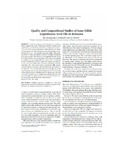Quality and Compositional Studies of Some Edible Leguminosae Seed Oils in Botswana

View/
Date
1998Author
Ketshajwang, K.K.
Holmback, J.
Yeboah, S.O.
Publisher
AOCS Press. http://www.springerlink.com/content/120382/Type
Published ArticleMetadata
Show full item recordAbstract
Seed oils were extracted with n-hexane from three
edible Leguminosae seeds: Tylosema esculentum, Xanthocercis
zambesiaca, and Bauhinia petersiana, giving yields of 48.2,
17.6, and 20.8% (w/w), respectively. Some physical and chemical
parameters were determined to ascertain the general characteristics
of the oils. The saponification and iodine values indicated
that all three oil samples could be classified among the
olive group of oils. This inference was supported by the results
of the detailed fatty acid composition of the oils as determined
by capillary gas chromatography. The ratio of total unsaturated
to total saturated fatty acids in all three oil samples was approximately
70:30, with either oleic or linoleic acid being the dominant
fatty acid. These results were in agreement with a proton
nuclear magnetic resonance analysis of the fatty acid classes in
the seed oils. Thus, the analysis served to justify the use of the
three Leguminosae seed oils in food preparations. The work has
further indicated that, with their attractive properties, the seed
oils from T. esculentum, X. zambesiaca, and B. petersiana are
good candidates for further studies to evaluate their future commercial
prospects in the Southern African region.
